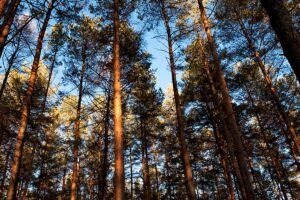Everybody that I know wants an answer to that question. Nobody that I know has a firm grasp on anything that can totally predict it. There are simply too many variables for that to be a “known.” But, that does not stop us from giving it a go. Those of us that consider ourselves land professionals like to think we can predict the market. I’ve got a feeling that those people we dispense our knowledge upon look at it with slightly more doubt than the prognostications they hear from their local meteorologist during the evening news. However, as professionals do, we push onward.
Beginning in the Spring of this year, LANDTHINK.com conducted an online survey of buyers and sellers of land. Among the questions posed to the respondents was, “Where do the you think we are in the current land real estate market?”. The answer from the 860+ respondents was a collective, “I have no idea.” Just over 21% of those polled think we are currently at the bottom. Almost 17% thought that the bottom has already passed. 43% think we will find the bottom within the next year, and 18% said that we were not within site of the bottom. I think this is very similar to the collective of what I hear from customers day in, day out. It’s not uncommon for me to spend 15 minutes on the phone with someone that is completely convinced we are headed for a deep, deep depression. I think some of this is gamesmanship in trying to get a better deal though. I also spend a great deal of time talking with those that think the worst is behind us and are thinking of dipping their toes back in the water of real estate investment. Ironically, uncertainty about the market keeps driving the uncertainty of the market. It makes one think that knowing for certain the market is still headed down might somehow give us a better map out of the entire mess. Indeed, I know another land broker that, about a year ago, told me, “I’m ready for the market to go ahead and fall off the cliff. Then we can sort it out.” I’m not so Gung-Ho on his notion, but I can almost see the logic.
John Wieland Homes and Neighborhoods, dissected the Atlanta metro area residential market to us. Using data from the MLS there and in-house sources he presented the numbers in such a fashion that would lead you to believe that the low point in that market is in sight, but not past, and that Spring 2011 should see some improvement…however slight. In that the land market has tended to lag behind the residential markets and has been infinitely less volatile, I think that it is logical to conclude that those land markets that are so heavily influenced by those living in the Atlanta area are going to continue to be remarkably flat. Once there is significant improvement in the residential market there, look for the land market to improve marginally within a few months. I would imagine this to be true for the influence on land prices around any major metropolitan area. Indeed out West, where some of the first severe corrections occurred in the residential market, and have since began a rebound, you can see an uptick in the land market as well.
Specific to my area here in East Central Alabama, we have a great deal of influence from Atlanta and Birmingham. Birmingham did not quite reach the highs that Atlanta did during the boom and has not seen the same kind of lows that Atlanta is now suffering. That has served to temper the market here in rural East Central Alabama in comparison to what it would have been had Atlanta been our only metro-area influence.
Timberland and timber markets were also discussed heavily at the LANDTHINK Summit. Unlike some of our other discussions, the general thoughts on timber markets were more positive and had less uncertainty. This leads to a more predictable timberland market. One of the most notable pieces of information that I gleaned from the discussion yesterday was that paper companies were back into the land market…as buyers. This definitely signals that there has been enough of a price correction on timberland properties to make the managers and economists with those companies think owning land for growing trees might be profitable again. Private investors should take note of this. With the more specific management a private investor can provide on a property, he should be able to squeeze out a profit, even when the institutional investors cannot. This represents opportunity.
The timber markets are being strengthened from the bottom. The more uses there are for a particular commodity, the more demand there should be for it. Biomass and biofuels are beginning to put a bottom-certain in the pulp markets. While both biomass and biofuels can use forest refuse in production, it may be more cost effective to use pulp as an input that is currently easier to transport and more consistent. In the future I see both pulp and forest waste being substituted for one another in these production processes. This gives the timberland owner the opportunity to extract some value from forest waste that has traditionally gone unused and has even been a net cost to the owner due to clean-up. This, in turn, helps the value of timberland. There were several other ideas presented that indicated a favorable outlook in the timber markets. I will leave that to someone more qualified than I to present.
The general notion that I took from the discussions was favorable for timberland investments. The low cost of money right now figures heavily into this. For private investors, the Farm Credit lending cooperatives are offering fairly good financing terms and ultra-low rates on good timberland properties. They are also in tune with the production cycle of timberland and are willing to work with those cycles in your repayment plans.
So, here we go. The answer to the million dollar question. Maybe. Timberland is a buy. If you have some holding power, transitional lands (land that is moving from one use to another due to market forces) purchased at current markets will look like great investments in 5-10 years. If you are someone looking to buy 40-100 acres in the country that you will use for a retirement homesite or getaway place, and have the funds for a 20% down payment, I think now is a good time to make that investment. I do not foresee a significant drop in prices on the horizon. I see the general market staying flat for a couple years…but not interest rates. Fortunes are made by those who buy low and sell high. Today represents an opportunity to buy low with cheap funds. Can you buy lower tomorrow? Maybe…but not alot. Will you be able to borrow money tomorrow as cheaply as today? Not likely. If you have been waiting for someone to tell you it’s time…It’s time.
In a year from now, you will know if you can look back at me as someone who is “Land Smart” or not! Until then, it’s just an educated guess. Just like the weatherman.
This content may not be used or reproduced in any manner whatsoever, in part or in whole, without written permission of LANDTHINK. Use of this content without permission is a violation of federal copyright law. The articles, posts, comments, opinions and information provided by LANDTHINK are for informational and research purposes only and DOES NOT substitute or coincide with the advice of an attorney, accountant, real estate broker or any other licensed real estate professional. LANDTHINK strongly advises visitors and readers to seek their own professional guidance and advice related to buying, investing in or selling real estate.










Right on and it is about time someone asked the question. I was not able to attend the Land Summit, but I am glad to see such a great turn out.
Congratulations Lisa and Ryan for the great effort and program you had.
Lou Jewell ALC
Thanks Lou. I was hoping to get to meet you at the conference. Maybe next year!
Robert, I think you hit the nail on the head in your closing remarks. Most financial people I listen to think that the cost of borrowing money is about to go up, and some say ridiculously. Getting a fixed-rate 20 year loan on land at these rates is probably about as good as we’re going to see any time in the near future. My feeling is that it is a good time to buy recreational tracts that are priced well if you are planning to hold them for a few years and use them.
Good article.
buy prime ag land,with the best yields,preferably on a river with the views to boot,our greatest threat now is taxation,so grow food and youll be safe,everything else is fools gold.
We have seen downward pressure on pricing in Kentucky for timber land and recreational land, so more landowners are choosing to do select cuts on their timber for cash now instead of selling the land.
Ag land is selling at great prices and selling quickly, but it may mean that ag land is peaking in the near term.
For this area, the value deals seem to be recreational and timber land.